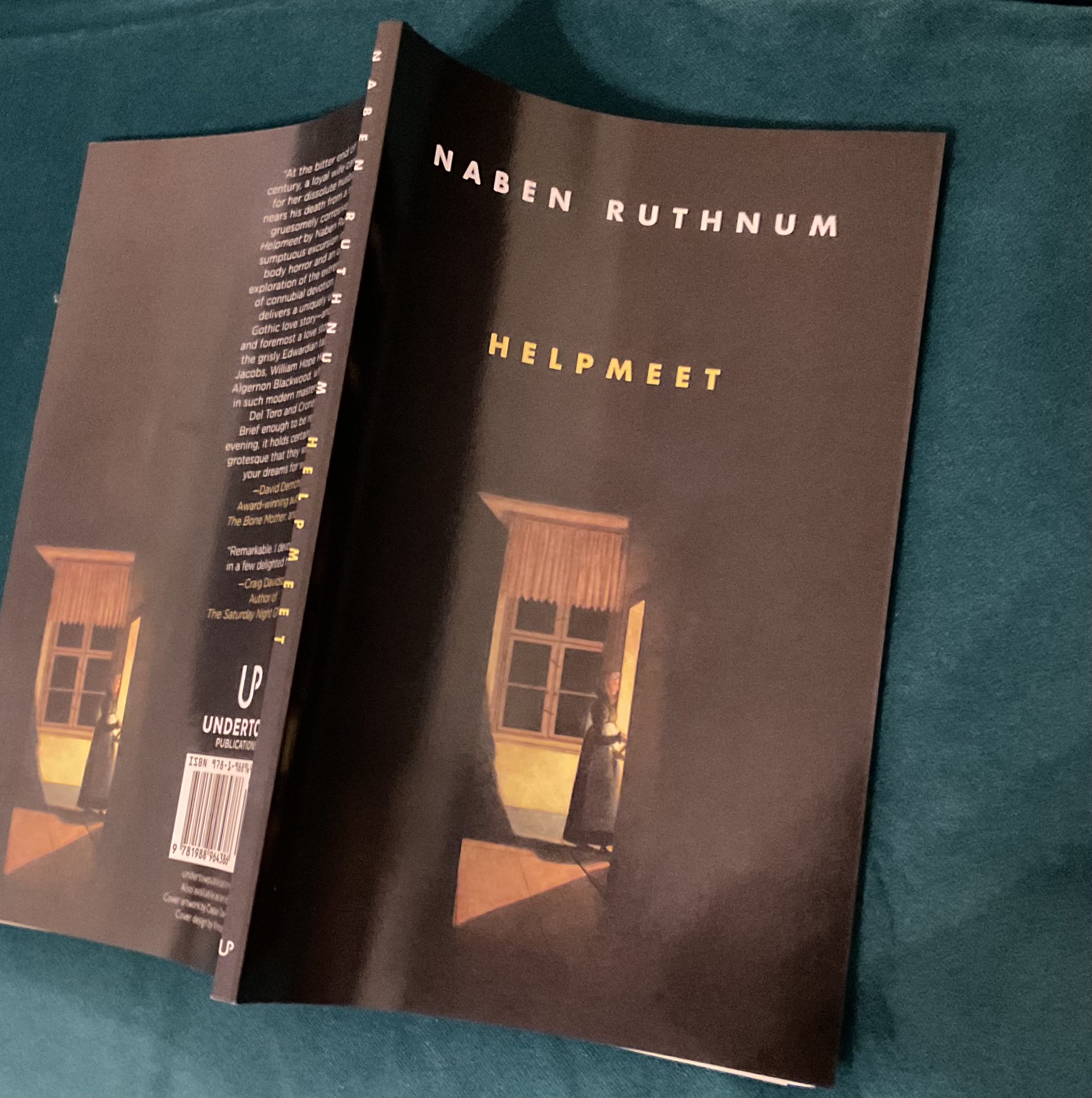
UNDERTOW Publications 2022
My previous reviews of this publisher: https://dflewisreviews.wordpress.com/tag/undertow-publications/
When I read this book, I hope to give my thoughts on it in the comment stream below….
Share this:
Related
All The Things We Never See – Michael KellyIn "Jonathan William hodges"
I Would Haunt You If I Could – Seán Padraic BirnieIn "Sean Padraic birnie"
Thin Places – Kay ChronisterIn "Kay Chronister"
2 thoughts on “Helpmeet — Naben Ruthnum”
3
“Edward suited his missing nose and eyes. They would have been an intrusion if they regenerated.”
…as would my emptying brain, should it fill it up again. Edward, gradually waking, with his true helpmeet, his wife, Louise, arrives at his old Buffalo house, seemingly, for me, unexpectedly empty itself, but with issues concerning neighbours and its orchards, a transport assisted by another passing helpmeet called Tom, but the prose used to describe Edward’s terminal state, as Louise settles him in, needs no helpmeet at all. It is aesthetically disturbing, haunting but eventually it is, in turn, a helpmeet to any readers who want to face such dark sights, especially in the light of Louise’s faithful palliative care for such a ruthfully numbed sufferer. But does someone else come, I suddenly wonder?
I forgot to post the 4th entry here yesterday, but luckily I retrieved it from my notebook…
4
We see into Edward’s ‘disordered’ mind, and my own disordered mind does not help his, yet I sense he sees Jean, the whore I wonder, who he thinks, commingled with Louise, once gave him the still encroaching disease as retribution for his body having invaded hers, and this time she has entered his. But the disorder of his discards is pre-mapped by meticulous chalk-lines on the floor as if such Found Art was strictly planned out after all.
5
“And a right elbow, an elbow on the part of your chaise where it just started to slope upward. I could see the elbow on the green felt, but I couldn’t remember the rest of the arm.”
A most moving chapter for all readers, but especially for lovers of the elbow-trigger in literature, an instinctive device often used in fiction over the centuries as I have discovered empirically. Echoing Edward’s dreams of Jean, and/ or Louise’s dreams of Jean who had entered Edward and possibly given him this wasting disease, and now his tongue had sloughed from his mouth like a slug overnight. But osmosis via Louise, his discrete wife and discrete nurse combined, I sense, will still work for him, if not speech. Louise says of herself, vis à vis Jean, that she “followed the elbow to her arm,… […] ….her hand vanished into you.”
Coincidentally, yesterday, I created this new Facebook Group, ART PHOTOS OF ELBOWS AND ELBOW SHAPES…
https://www.facebook.com/groups/440357875016540/?ref=share_group_link
6
“Then Louise looked at the dragged path she’d made from the elm root.”
This is a surely unforgettable tour de force describing Edward’s managing to flee, even in his state, into the mulch of orchards on the verge of the forest, and his wife nurse as hELpMeet attempting to rescue both of him, or one of him from the other, from the fLOWEr?
Only reading this chapter will do justice to its power.
7
“…to smell it, to smell the living Edward inside it.”
Whether this be a theme and variations on Mary Shelley, or a nod towards reincarnation, or a shape-shifting between lovers that is new to literature, we have here a short chapter that will penetrate the rest of my days. Even Watch with Mother back to when I was too young to understand, and maybe the house knew something about it, too.
9
“With the correct letters written… […] The flower left in Isabel…”
The power of this book endures. Impossible to interpret or evaluate, let alone describe. A story that is bespoke to each reader depending on how much ‘they’ take into themself in this new pronoun world. A sort of bodily ventriloquism as an extrapolation of Shirley Jackson’s ‘written ventriloquism’ recently reviewed HERE. A comparison that is also generally and inadvertently rewarding to each work.
END

I
“…the last book he would ever begin.”
Powerful and mesmeric descriptions of mysterious terminal disease in Edward as Louise plans, with help of her brother, to transport him by train to his rightful home, where squat other members of his family, near Buffalo. The disease itself has to be read about to be felt without the morphia of not reading it at all to dull its effects, but aesthetic, if not anaesthetic, in a Happenstantial way when Louise plays with gauze of his fluids as ‘found’ fine art and, I infer, with cotton bud residue, too. Ruthfully numb.
2
“; now, speaking the name and starting the story brought the rest of it back.”
A chapter of light and dark. The interaction of brother and sister in the light of their own backstory and her husband’s possibly suspicious disease, as they manhandle his lightening body like luggage by carriage to the sleeper. A nameless disease’s aura of Conan Doyle at his most gruesome and literary works of darkness that even corrode the co-vivid rust of the future? Thoughts, too, of the closer future for her. And what is in store, apotheosised by further fine art aesthetics of residue from ill wounds, as filtered by reality’s own natural light. And what of Nanda whose name we learn — as helpmeet?
All couched in a beautiful book, with its own aesthetics, as well as anaesthesia of watermarks…